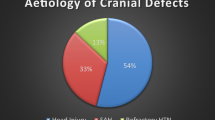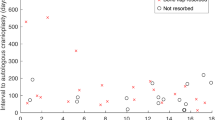Abstract
Purpose
To introduce a method of cranial bone reconstruction for cranial burst fractures and early-stage growing skull fractures, named bone flap binding and transposition.
Methods
Cranial burst fractures, severe head injuries predominantly observed in infants, are characterized by widely diastatic skull fractures coupled with acute extracranial cerebral herniation beneath an intact scalp through ruptured dura mater. These injuries can develop into growing skull fractures. This study included two cases to illustrate the procedure, with a particular focus on the bone steps in managing these conditions. The medical history, clinical presentation, surgical procedures, and postoperative follow-up were retrospectively studied. The details of the surgical procedure were described.
Results
The method of bone reconstruction, named bone flap binding and transposition, was applied after the lacerated dural repair. Two bone pieces were combined to eliminate the diastatic bone defect and then fixed by an absorbable cranial fixation clip and bound by sutures. The combined bone flap was repositioned into the bone window, completely covering the area of the original dural laceration. Subsequently, the bone defect was transferred to the area of normal dura. The postoperative courses for the two infants were uneventful. Follow-up CT scans revealed new bone formation at the previous bone defect and no progressive growing skull fracture. The major cranial defects had disappeared, leaving only small residual defects at the corners of the skull bone window, which required further recovery and did not affect the solidity of the skull.
Conclusion
Bone flap binding and transposition provide a straightforward, cost-effective, and reliable method for cranial bone reconstruction of cranial burst fractures and early-stage growing skull fractures. This method has taken full advantage of the small infant’s dura osteogenic potential without the need for artificial or metallic bone repair materials. The effectiveness of the method needs further validation with more cases in the future.


Similar content being viewed by others
Data availability
No datasets were generated or analyzed during the current study.
References
Donahue DJ, Sanford RA, Muhlbauer MS, Chadduck WM (1995) Cranial burst fracture in infants: acute recognition and management. Childs Nerv Syst 11:692–697. https://doi.org/10.1007/bf00262233
Ellis TS, Vezina LG, Donahue DJ (2000) Acute identification of cranial burst fracture: comparison between CT and MR imaging findings. AJNR Am J Neuroradiol 21:795–801
Yang CH, Li Q, Li GP, You C (2009) Internal open brain injury or cranial burst fracture: report of 8 cases. Pediatr Neurosurg 45:402–406. https://doi.org/10.1159/000260912
Singhal A, Steinbok P (2008) Operative management of growing skull fractures: a technical note. Childs Nerv Syst 24:605–607. https://doi.org/10.1007/s00381-007-0552-x
Tamada I, Ihara S, Hasegawa Y, Aoki M (2019) Surgical treatment of growing skull fracture: technical aspects of cranial bone reconstruction. J Craniofac Surg 30:61–65. https://doi.org/10.1097/scs.0000000000004949
Johnson DL, Helman T (1995) Enlarging skull fractures in children. Childs Nerv Syst 11:265–268. https://doi.org/10.1007/bf00301756
Lopez J, Chen J, Purvis T, Reategui A, Khavanin N, Iyer R, Manson PN, Dorafshar AH, Cohen AR, Redett RJ (2020) Pediatric skull fracture characteristics associated with the development of leptomeningeal cysts in young children after trauma: a single institution’s experience. Plast Reconstr Surg 145:953e–962e. https://doi.org/10.1097/prs.0000000000006745
Sheng HS, Zhang N, Lin J, Lin FC, Yin B, Wang MD (2016) Delayed surgical repair of cranial burst fracture without strict dura closure: a prudent choice in selected patients? Childs Nerv Syst 32:1661–1667. https://doi.org/10.1007/s00381-016-3155-6
de Djientcheu PV, Njamnshi AK, Ongolo-Zogo P et al (2006) Growing skull fractures. Childs Nerv Syst 22:721–725. https://doi.org/10.1007/s00381-005-0010-6
Marshall KW, Koch BL, Egelhoff JC (1998) Air bag-related deaths and serious injuries in children: injury patterns and imaging findings. AJNR Am J Neuroradiol 19:1599–1607
Zemann W, Metzler P, Jacobsen C, Kruse AL, Lübbers HT, Könü D, Obwegeser JA (2012) Growing skull fractures after craniosynostosis repair: risk factors and treatment algorithm. J Craniofac Surg 23:1292–1295. https://doi.org/10.1097/SCS.0b013e31825435d5
Prasad GL, Gupta DK, Mahapatra AK, Borkar SA, Sharma BS (2015) Surgical results of growing skull fractures in children: a single centre study of 43 cases. Childs Nerv Syst 31:269–277. https://doi.org/10.1007/s00381-014-2529-x
Singhal GD, Atri S, Suggala S, Jaluka D, Singhal S, Shrivastava AK (2021) Growing skull fractures; pathogenesis and surgical outcome. Asian J Neurosurg 16:539–548. https://doi.org/10.4103/ajns.AJNS_183_18
Singla N, Gupta SK (2010) The natural history of an untreated growing skull fracture: an unusual case. Pediatr Neurosurg 46:76–79. https://doi.org/10.1159/000315322
Vezina N, Al-Halabi B, Shash H, Dudley RR, Gilardino MS (2017) A review of techniques used in the management of growing skull fractures. J Craniofac Surg 28:604–609. https://doi.org/10.1097/scs.0000000000003379
Singh I, Rohilla S, Siddiqui SA, Kumar P (2016) Growing skull fractures: guidelines for early diagnosis and surgical management. Childs Nerv Syst 32:1117–1122. https://doi.org/10.1007/s00381-016-3061-y
Author information
Authors and Affiliations
Contributions
Hongbin Cao performed the surgery and drafted the manuscript. Genrui Guo collected the data, conducted the literature review, and assisted in drafting the final version of the manuscript.
Corresponding author
Ethics declarations
Ethics approval
This study was reviewed and approved by the Ethics Committee of our hospital, ensuring compliance with the institution’s ethical standards and adherence to national guidelines for retrospective studies.
Conflict of interest
The authors declare no competing interests.
Additional information
Publisher's Note
Springer Nature remains neutral with regard to jurisdictional claims in published maps and institutional affiliations.
Rights and permissions
Springer Nature or its licensor (e.g. a society or other partner) holds exclusive rights to this article under a publishing agreement with the author(s) or other rightsholder(s); author self-archiving of the accepted manuscript version of this article is solely governed by the terms of such publishing agreement and applicable law.
About this article
Cite this article
Cao, H., Guo, G. Bone flap binding and transposition: a method for bone reconstruction in cranial burst fractures and early-stage growing skull fractures. Childs Nerv Syst (2024). https://doi.org/10.1007/s00381-024-06373-0
Received:
Accepted:
Published:
DOI: https://doi.org/10.1007/s00381-024-06373-0




